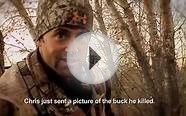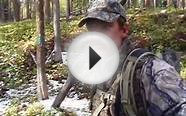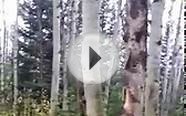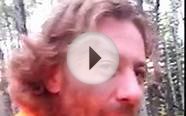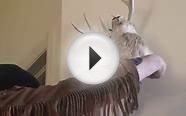Colorado hunting season
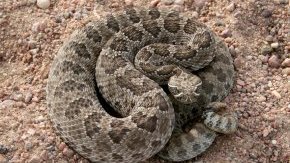
Colorado Rattlesnakes: What Sportsmen Should Know
Springtime in Colorado is a great season. The warm days provide a glimpse as to what lies ahead, while the cool nights remind us that winter hasn’t retired quite yet. It’s also a time when nature begins waking up; leaves bud out, migratory birds return and (my favorite) the reptiles reappear.
In fact, I had my first report of a snake just a couple weeks ago. Amazingly enough, the e-mail arrived during a spring snowstorm, though, the picture was obviously taken days earlier in the warm sunshine.
This particular identification was easy: a young-of-the-year racer, really no bigger than a typical ink pen. Although most of Colorado’s snake species pose no threat to humans, I’ve been working with snakes and educating the public long enough to know not everyone believes this to be true. And because of their appearance, snakes evoke fear in many people, which almost always is unwarranted.
Colorado is home to about 30 species of snakes. Of these, only three snakes are a risk to humans: the prairie rattlesnake, the Western rattlesnake (also known as the midget-faded rattlesnake) and the massasauga rattlesnake. Do you see the pattern here? The only venomous snakes native to Colorado are rattlesnakes.
Prairie rattlesnakes are abundant and are found statewide in nearly every type of habitat (prairies, foothills, riparian corridors and towns/suburbs) below 9, 000 feet. The Western rattlesnake, hence the name, is found west of the Continental Divide, primarily along the Colorado/Utah border. The third species, the massasauga, is a small rattlesnake localized to the sandy terrain of southeastern Colorado.
So as we humans change our routines from winter outdoor pursuits like ice fishing, skiing, and competitive hot-chocolate drinking, to spring fly fishing, turkey hunting, hiking and general vitamin-D replenishment, we have more chances to bump into a rattlesnake or two.
Meeting a snake on the trail to your favorite fishing hole or hunting spot is not a huge cause for concern, if you remember a few safety tips and understand snake behavior.
1. Rattlesnakes Prefer to Hide
Rattlesnakes are cryptic and use camouflage as their first line of defense. They would rather hide than interact with humans or other animals. Because of their coloration, most rattlesnakes blend in with their surroundings exceptionally well. In most cases, they will simply ignore you, thinking that you cannot see them. However, if the snake coils up and rattles, you are too close and should move away slowly. Stepping back just a few feet can be enough to convince the snake that you are not a threat. Most rattlesnakes will not strike at people unless they feel threatened or are deliberately provoked.
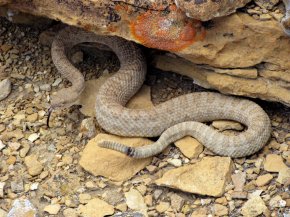 2. Don’t Touch Any Snake
2. Don’t Touch Any Snake
Even though only three of our native snakes are venomous, all snakes have teeth and know how to use them. Regardless of the species, it’s a good idea never to handle any snake. Contrary to popular belief, snakes don’t need to be moved off a trail or “helped” anywhere, although, a snake using the road as a heating pad might appreciate some coaxing to the shoulder. Most people get bit on the hands, so you can limit your chances by keeping your digits out of range.
3. Watch Where You Put Your Feet and Hands
Remember: Snakes like to hide. So on rocky trails or areas with downed trees, be sure to check what’s on the other side before putting your appendage there. It’s also a good idea to avoid hiking in tall grass where you cannot see what’s lurking below. Move slowly and use a walking stick to check what lies ahead before stepping forward. A pair of snake-proof boots or high-top hiking boots can provide additional protection if you are walking in known rattlesnake country. When hiking, it’s also best to leave the iPod at home so you can hear a snake’s warning rattle.
4. Keep Dogs Close to You
Dogs are curious and snakes are defensive—a bad combination. Unfortunately, a snake isn’t going to take the time to determine if that large, canine nose headed in their direction is a curious domestic dog or a wild coyote or fox that is searching for a snake dinner. On hiking trips, you should keep dogs on a short leash. Hunters using bird dogs should be especially mindful of rattlesnakes during dove season and the early part of pheasant season prior to the first winter freeze. Training your hunting dog to avoid snakes may also help prevent bites. Although somewhat controversial, some veterinarians are now administering a rattlesnake vaccine, which can help minimize the effects of a snakebite. It’s best to check with your veterinarian for recommendations, as opinions and treatments vary. If a dog gets bitten, it’s important to seek veterinary treatment as soon as possible.
5. If You Get Bitten by a Snake, Don’t Panic
As mentioned above, most snakes in Colorado are not venomous. But no matter what species administered the bite, the best option is to have it looked at by a doctor. Don’t try any of the Western remedies you’ve heard about like cutting open the bite and attempting to suck out the venom. Leave the bite alone and seek medical attention as quickly as possible. The best “first-aid kit” for a snake bite is your cell phone and car keys. If possible, call ahead to the medical facility so doctors can be prepared with the appropriate treatments.
6. Remember: Snakes Benefit Our Ecosystems
All snakes, including rattlesnakes, play an important role in balancing our ecosystems. Snakes eat rats, mice, prairie dogs, and they help control insects and other “pests.” Snakes also sit in the middle of the food chain, providing food for raptors and other predators. Respect and enjoy snakes when you see them in the wild.
By taking these simple precautions, it will help ensure that your time spent in the outdoors this spring and summer is both safe and enjoyable.
__________________________
This article was written by Tina Jackson. Jackson is the species conservation coordinator for Colorado Parks and Wildlife. She became fascinated with snakes in childhood and has spent the last 10 years learning about snakes and sharing her knowledge with others.
You might also like
